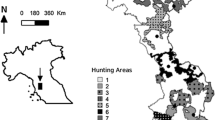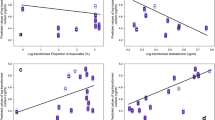Summary
We studied the behavior and copulatory success of fallow deer (Cervus dama) males at a lek. We recorded 471 copulations in 3 years. Most males did not copulate. The top three males accounted for between 60 and 90% of copulations each year. Lek attendance time was the major determinant of male copulatory success, but territory location also affected the number of copulations achieved. Copulatory success was correlated with the number of females in a male's territory and possibly with dominance status, but not with fighting success or fighting rate. All males that defended lek territories were 5 years of age or older. Copulatory success may improve with age. Body condition appears to be an important determinant of male copulatory success, because only males in superior condition could defend a lek territory for up to 2 weeks. Males do not feed while defending lek territories. Foraging ability during the year probably determines condition at the onset of the rut. Females appear to choose mates at least partially on the basis of location, preferring males located near traditional routes. Females may ultimately select mates in the best body condition.
Similar content being viewed by others
References
Apollonio M, Festa-Bianchet M, Mari F, Riva M (in press) Site-specific asymmetries in male copulatory success in a fallow deer lek. Anim Behav
Asher GW (1985) Oestrous cycle and breeding season of fallow deer, Dama dama. J Reprod Fert 75:521–529
Bradbury JW, Gibson RM (1983) Leks and mate choice. In: PPG Bateson (ed) Mate choice. Cambridge University Press, Cambridge, pp 109–138
Buechner HK (1961) Territorial behavior in Uganda kob. Science 133:698–699
Buechner HK, Schloeth R (1965) Ceremonial mating behaviour in Uganda kob (Adenota kob thomasi Neuman). Z Tierpsychol 22:209–225
Clutton-Brock TH, Albon SD, Gibson RM, Guinness FE (1979) The logical stag: adaptive aspects of fighting in red deer (Cervus elaphus L.). Anim Behav 27:211–225
Clutton-Brock TH, Guinness FE, Albon SD (1982) Red deer: behavior and ecology of two sexes. University of Chicago Press, Chicago
Clutton-Brock TH, Green D, Hiraiwa-Hasegawa A, Albon SD (1988) Passing the buck: resource defence, lek breeding and mate choice in fallow deer. Behav Ecol Sociobiol 23:281–296
Dewsbury DA (1982) Dominance rank, copulatory behaviour, and differential reproduction. O Rev Biol 57:135–159
Floody DR, Arnold AP (1975) Uganda kob (Adenota kob thomasi) territoriality and the spatial distribution of sexual and agonistic behaviours at a territorial ground. Z Tierpsychol 37:192–212
Fryxell JM (1987) Lek breeding and territorial aggression in white-eared kob. Ethology 75:211–220
Geist V (1971) Mountain sheep. University of Chicago Press, Chicago
Geist V (1986) New evidence of high frequency of antler wounding in cervids. Can J Zool 64:380–384
Gibson RM, Bradbury JW (1985) Sexual selection in lekking sage grouse: phenotypic correlates of male mating success. Behav Ecol Sociobiol 18:117–123
Gosling LM (1987) Scent-marking in an antelope lek territory. Anim Behav 35:620–622
Gosling LM, Petrie M, Rainy ME (1987) Lekking in topi: a high-cost, specialist strategy. Anim Behav 35:616–618
Halliday TR (1987) Physiological constraints on sexual selection. In: Bradbury JW, Andersen MB (eds) Sexual selection: testing the alternatives. Wiley & Sons, New York, pp 247–264
Lande R, Arnold SJ (1983) The measurement of selection on correlated characters. Evolution 37:1210–1226
LeBoeuf BJ (1974) Male-male competition and reproductive success in male elephant seals. Am Zool 14:163–176
Lewis RA, Zwickel FC (1980) Removal and replacement of male blue grouse on persistent and transient territorial sites. Can J Zool 58:1417–1423
Miura S (1984) Social behavior and territoriality in male sika deer (Cervus nippon Temminck 1838) during the rut. Z Tierpsychol 64:33–73
Montfort-Braham N (1975) Variations dans la structure sociale du topi, Damaliscus korrigum Ogilby, au Parc National de l'Akagera, Rwanda. Z Tierpsychol 39:332–364
Pemberton JM, Balmford AP (1987) Lekking in fallow deer. J Zool 213:762–765
Rippin AB, Boag DA (1974) Spatial organization among male sharp-tailed grouse on arenas. Can J Zool 52:591–597
Schaal A, Bradbury JW (1987) Lek breeding in a deer species. Biol Behav 12:28–32
Schuster RH (1976) Lekking behavior of Kafue lechwe. Science 192:1240–1242
Sokal RR, Rohlf FJ (1981) Biometry, 2nd edn. Freeman and Co., San Francisco
Author information
Authors and Affiliations
Rights and permissions
About this article
Cite this article
Apollonio, M., Festa-Bianchet, M. & Mari, F. Correlates of copulatory success in a fallow deer lek. Behav Ecol Sociobiol 25, 89–97 (1989). https://doi.org/10.1007/BF00302925
Received:
Accepted:
Issue Date:
DOI: https://doi.org/10.1007/BF00302925




